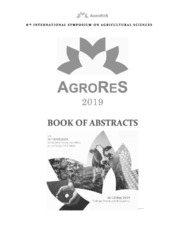Приказ основних података о документу
Maize yield in different systems of soil tillage and regime of fertilizer application
| dc.creator | Simić, Milena | |
| dc.creator | Dragičević, Vesna | |
| dc.creator | Brankov, Milan | |
| dc.creator | Kresović, Branka | |
| dc.creator | Tolimir, Miodrag | |
| dc.date.accessioned | 2022-10-18T06:10:57Z | |
| dc.date.available | 2022-10-18T06:10:57Z | |
| dc.date.issued | 2019 | |
| dc.identifier.isbn | 978-99938-93-54-7 | |
| dc.identifier.uri | http://rik.mrizp.rs/handle/123456789/1007 | |
| dc.description.abstract | Appropriate soil tillage and fertilizer application are two prerequisites for successful maize production, especially in dry years. Research of different tillage systems on the chernozem soil type in Zemun Polje, Belgrade, Serbia was initiated in 1978. The effects of three tillage systems: no-tillage, rotary tillage and conventional tillage, and three levels of fertilization: F1- control, F2 - 330 kg ha–1 NPK and F3- 660 kg ha–1 NPK, on the maize yield and quality of grains were analyzed. The experiment was conducted under rain-feed and irrigated conditions as split-plot design with four replicates, during 2017 and 2018. In the no-tillage treatment, planting was performed by direct maize planting, John Deere 7200. In the reduced tillage treatment, tillage was performed with a rotovator in the autumn and planting with a conventional drill. The conventional tillage treatment consisted shallow plowing, immediately after wheat harvesting, primary tillage in the autumn and seedbed preparation in the spring. The plant density of ZP606 hybrid was 64.935 plants ha-1 . After the harvest, protein, starch and oil content in maize grains were analyzed. In 2017 in Zemun Polje the drought period was present (June September) while 2018 was favorable for maize production and irrigation was not applied. The highest yields were obtained within conventional system of soil tillage and with application of mineral fertilizers. In 2017 the most effective was F2 under rain-feed (5.98 t ha-1 ) and irrigation conditions (9.02 t ha-1 ). During 2018, as a year with adequate amount and distribution of precipitation, more effective was F3 under rain-feed (10.50 t ha-1 ) and F2 under irrigation conditions (10.43 t ha-1 ). In both years, parallel with amount of fertilizer increasing, the protein content in maize grains increased, while starch and oil content showed opposite trend. The medium and high macronutrient supply to the soil, together with conventional tillage, are optimal for high yield achievement. | sr |
| dc.language.iso | en | sr |
| dc.publisher | Banja Luka : University of Banja Luka, Faculty of Agriculture | sr |
| dc.rights | openAccess | sr |
| dc.rights.uri | https://creativecommons.org/licenses/by/4.0/ | |
| dc.source | 8. International symposium on agricultural sciences "AgroReS 2019", Trebinje, 16-18.05.2019. - Book of abstracts | sr |
| dc.subject | soil tillage | sr |
| dc.subject | fertilization | sr |
| dc.subject | maize grain | sr |
| dc.subject | protein content | sr |
| dc.title | Maize yield in different systems of soil tillage and regime of fertilizer application | sr |
| dc.type | conferenceObject | sr |
| dc.rights.license | BY | sr |
| dc.citation.spage | 38 | |
| dc.citation.epage | 38 | |
| dc.identifier.fulltext | http://rik.mrizp.rs/bitstream/id/4854/3,2019.pdf | |
| dc.identifier.rcub | https://hdl.handle.net/21.15107/rcub_rik_1007 | |
| dc.type.version | publishedVersion | sr |


